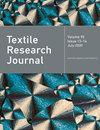用不同聚合物间隔单丝的形态和机械变化解释间隔织物的抗压性和回弹性
IF 1.9
4区 工程技术
Q2 MATERIALS SCIENCE, TEXTILES
引用次数: 0
摘要
定制具有所需抗压性和回弹性的间隔织物对于促进其技术应用至关重要。压缩性能主要取决于用作间隔纱的单丝的机械特性。本研究通过分析 40% 应变时的压缩应力、残余应变和循环压缩试验的能量吸收,研究了用不同聚合物单丝编织的间隔织物的压缩性能。在循环压缩前后,织物中的单丝被解开,以测试其拉伸性能和形态,从而解释其不同的织物压缩性能。研究发现,针织单丝会大幅改变其宏观和/或微观结构,从而影响间隔单丝的机械行为,并产生不同的织物结构和压缩性能。编织聚对苯二甲酸乙二醇酯单丝会破坏中间相,导致杨氏模量下降三分之二,而编织聚酰胺 6 和聚对苯二甲酸丁二醇酯单丝则会在很大程度上改变宏观结构,但仍能保持良好的回弹性。用较硬的聚对苯二甲酸乙二醇酯单丝编织的间隔织物具有较好的抗压性,但压缩回弹性较差,而用较柔软、回弹性较好的聚酰胺 6 和聚对苯二甲酸丁二醇酯单丝编织的间隔织物则具有较好的压缩回弹性。聚乙烯单丝由于杨氏模量低、拉伸回弹性差,不适合用作间隔织物。根据 EN ISO 3386-1 标准的要求,聚对苯二甲酸乙二醇酯间隔织物在 40% 应变时的压缩应力和第四个周期的残余应变方面具有最佳的抗压缩性-回弹性平衡,而聚酰胺 6 和聚对苯二甲酸丁二醇酯单丝由于具有较高的抗压缩性和回弹性,更适合长期使用。本文章由计算机程序翻译,如有差异,请以英文原文为准。
Interpreting compression resistance and resilience of spacer fabrics with morphological and mechanical changes of different polymeric spacer monofilaments
Customization of spacer fabrics to have the desired compression resistance and resilience is critical to promote their technical applications. The compression properties are mainly determined by the mechanical features of monofilaments used as spacer yarns. This study investigates the compression properties of spacer fabrics knitted with different polymeric monofilaments by analyzing their compression stress at 40% strain, residual strain, and energy absorption from cyclic compression tests. The monofilaments in the fabrics before and after cyclic compression were unraveled to test their tensile properties and morphologies for interpreting their different fabric compression properties. It was found that knitting monofilaments substantially alters their macroscopic and/or microscopic structures, thereby affecting the mechanical behavior of spacer monofilaments, and having different fabric structures and compression properties. Knitting polyethylene terephthalate monofilament damages the mesophase and induces a two-thirds decline in Young's modulus, while knitting polyamide 6 and polybutylene terephthalate monofilaments largely alters the macrostructures but maintains their good resilience. Spacer fabrics knitted with stiffer polyethylene terephthalate monofilaments have superior compression resistance but inferior compression resilience, while those knitted with softer and more resilient polyamide 6 and polybutylene terephthalate monofilaments have better compression resilience. Polyethylene monofilament is not suitable for spacer fabrics because of its low Young's modulus and poor tensile resilience. Polyethylene terephthalate spacer fabrics have the best compression resistance–resilience balance in terms of compression stress at 40% strain and residual strain in the fourth cycle required by the standard EN ISO 3386-1, while polyamide 6 and polybutylene terephthalate monofilaments are more suitable for long-term service due to their high compression resistance and resilience.
求助全文
通过发布文献求助,成功后即可免费获取论文全文。
去求助
来源期刊

Textile Research Journal
工程技术-材料科学:纺织
CiteScore
4.00
自引率
21.70%
发文量
309
审稿时长
1.5 months
期刊介绍:
The Textile Research Journal is the leading peer reviewed Journal for textile research. It is devoted to the dissemination of fundamental, theoretical and applied scientific knowledge in materials, chemistry, manufacture and system sciences related to fibers, fibrous assemblies and textiles. The Journal serves authors and subscribers worldwide, and it is selective in accepting contributions on the basis of merit, novelty and originality.
 求助内容:
求助内容: 应助结果提醒方式:
应助结果提醒方式:


